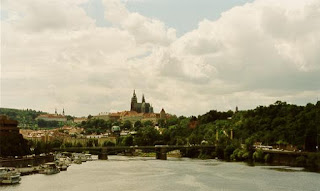 |
| El Camino del Rey from below |
El Caminito del Rey i.e. The King's Little Pathway is a well known place for climbers and adrenaline junkies, and it's not unusual to stumble upon stories about it in internet forums either. Myself, I had managed to avoid knowing of its existence until early this year when I had decided to go for another holiday on Costa del Sol. Since that Spanish coastal area is not necessarily on my top-places-to-go list - I merely go there because of family and friends (and the food) - I tried to find something different to do. And indeed something different I found.
 |
| Initial insanity |
Camino del Rey was built about one hundred years ago in a narrow gorge at El Chorro for hydroelectric power plant workers who needed access to control the water channels and to transport materials. During the decades, the walkway has slowly fallen into deterioration: the railing is missing for the most of the path, some sections have totally collapsed, other parts are waiting to fall down in the near future. The path is about one metre wide, and it's attached to vertical gorge wall mostly 100 metres high above the river flowing at the bottom.
 |
| Yours truly on a little potter |
After some fatal accidents the Andalucian Government has prevented extemporaneous hikers to enter the path by breaking the initial part of the walkway. It is still possible to use alternative routes to reach it, even without any gear. However, the safest way for people with very little, if any, climbing skills or experience (like me) is to join a guided tour with a professional climber guide who can provide the necessary gear and training. My brother tagged along for the hike, and we chose a Gibraltar-based outdoor, trekking and climbing activities providing company
Barbary Rock Adventures. It turned out to be a perfect choice for us. We got the gear, instructions on site, and an excellent guide Steve, who is one of the greatest guides I've ever had anywhere. A rock hard professional, who kept us safe, informed and very well entertained.

Our trek began with climbing an alternative route to the camino. That very first part alone was probably the freakiest trip I've ever done. We were clinging to a vertical limestone wall, moving sideways, having only narrow iron bars to step on. Then there was a section of almost straight upwards climbing on rock sediments that used to be sea bottom some hundreds of millions of years ago. Eventually we reached the underside of the pathway. Already from below it was obvious why camino is in such a state of disrepair: The mortar between the bricks is crumbling. The iron beams are almost corroded through. In many places the beams have been bound to iron rails with shabby copper wire. One hundred years ago.
 |
| The purpose of the pathway |
Once on the pathway there are no railings on most of the places, and we were looking at the river from about 100 meters above. Curiously, after the insane initial climbing part, standing and walking on the camino itself didn't cause any kind of vertigo. It was completely ok to reach over the edge and look down. Of course, crossing the broken parts of the path (there were several) caused some extra tempo in the pulse, but with the guide's instructions it all went relatively easily. The views on the camino are spectacular and they vary from the tiniest details like small crustacean fossils on the rockface to epic wide mountains, canyons and valleys. After couple of kilometres and some more balancing on the emptiness we reached the other end of the catwalk where there was a manual wheel operated lock on the nowadays crumbled water channel. Time for a packed lunch and some beverages. Walking Camino del Rey in 35 °C
scorchio is sweaty stuff.
 |
| One of the victims of Camino del Rey |
As if this all wasn't enough, we also went back the same way. Same broken sections, but now with the confidence of old and experienced camino-walkers. Almost. Our good guide Steve had also saved some tricks to show and he provided us with some extra information to keep our knowledge bases updated. Let's just say we now know much more for example about the peculiar correlation between excretive habits and gender. The final touch of the trip was to abseil down from the very beginning of Camino del Rey. Everyone else but me & my bro had abseiled before.
Oo, we have virgins here! snickered Steve. Usually when you start rehearsing abseiling, you do it from about six metre height, on somewhat slanting wall. Our first time was from 27 metres, on a sheer diagonal wall. It all went fine, although Steve mentioned the video material seeming oddly slow motion...
I wore a cheap head camera recording throughout the whole trip, having now hours of footage from our trek on Camino del Rey. I quickly composed the following video of the highlights of the walk.
After the hike we stopped at the El Chorro train station bar for a little rest. I swear beer has never tasted as good as the pint of San Miguel did then.
The Andalusian and Spanish Government have recently been making decisions and directing money to renovation of Camino del Rey in the near future. Those who want to experience it in its current decayed and dangerous, definitely fascinating state, better hurry.
Next entry:
The Abseil
Edit: Check also
the photo gallery!
















































